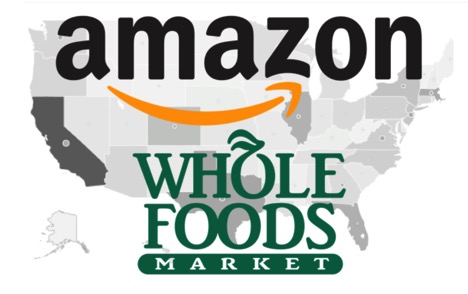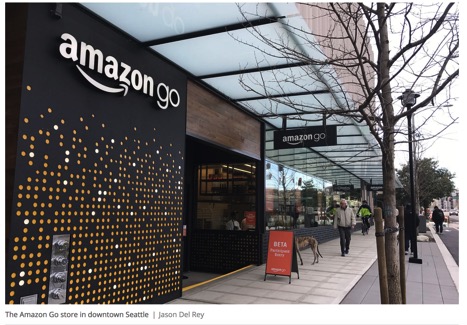Food for thought in the grocery business
Amazon has been in the news a lot lately, and rightly so. It’s fascinating to be sitting in their back yard where I get to see some of these innovations for myself.
In early 2017 they announced an experiment with Amazon Go, a cashier-less store of the future which hasn’t opened yet due to technical issues.
They are also experimenting with formats that allow customers to buy their items online, schedule time slots to pick them up, and drive to the pickup location where employees will deliver orders to their cars.
And in June Amazon introduced their Dash Wand with Alexa which lets you scan the bar codes for the items in your fridge, or just call them out – mushrooms! – to save to your shopping cart. It even helps you figure out what to do with the food you already have.
And when Amazon announced they would acquire Whole Foods for nearly $14B it sparked a whole lotta news.
Amazon’s latest acquisition of Whole Foods: a few industry perspectives
Local high tech publisher GeekWire’s story by Todd Bishop speaks to how the Amazon acquisition of Whole Foods grocery chain dramatically expands their physical retail footprint.
Felix Richter’s article in Statista speaks to the opportunity for Amazon to use Whole Foods’ distribution and procurement network to boost its online grocery offerings, to further penetrate the U.S. online grocery market – currently the ecommerce market for fast-moving consumer goods (FMCG) sales in the U.S. is only 1.4%, compared with 16.6% for South Korea.
A recent NYT article by Claire Cain Miller speaks to the acquisition signaling the end of the line for many cashiers.
And the Harvard Business Review article by Bill Taylor on Amazon, Whole Foods, and the Future of the (Old) New Economy offers a very thoughtful look at what the deal says about the future of an approach to business, branding, and organizational culture that Whole Foods and Amazon have come to represent.
I think all of these perspectives are valuable, but so far I have not seen anyone comment on what all of this means for the customer experience. As marketers I imagine we are all thinking about this question. So here is my take, and I welcome your thoughts:
4 marketing strategies Amazon seems to be following: a consumer perspective
The Amazon mission statement makes it clear what drives them – it’s serving consumers:
“Our vision is to be earth’s most customer-centric company; to build a place where people can come to find and discover anything they might want to buy online.”
I’m seeing this mission statement brought to life in a few ways:
1. Making Prime more valuable so more people sign up
Just as Gillette once priced their razors low so they could make money on razorblades, Amazon is looking to drive penetration of Prime membership so they can make money on what customers order. Part of the way Amazon markets Prime is by making this membership simple to get. But they are also working to make Prime more valuable, for example, if you sign up for Prime you’re the first group to get access to just about every new device or service they offer.
This includes getting Whole Foods products delivered to your doorstep.
Grocery is not in itself an attractive category – the margins are terrible. But offering grocery as a new category for home delivery increases delivery frequency, and once customers are ordering groceries regularly they’re also throwing in other products, which is attractive.
2. Lowering costs to consumers
When Amazon got into the e-book business they dropped the price to such a low level it put at least one publisher out of business.
Some analysts are already talking about the possibility of Amazon doing this for Whole Foods products.
3. Eliminating friction from the buying process
Consider everything Amazon has pioneered or pursued to make it as easy as possible to buy something from them online: low prices, one-click shopping, easy checkout, easy returns, free shipping.
In store they are experimenting with skipping the cash register entirely. With the Amazon Go app you’ll no longer need your wallet.
With the Dash Wand with Alexa you don’t need to write down your shopping list.
It wouldn’t surprise me if Amazon closes deals with smart refrigerators using Internet of Things (IOT) to automatically reorder your groceries for you, through Amazon of course.
What this eventually all adds up to …
4. Eliminating thinking altogether?
Every marketer works hard to build top of mind awareness and strives to get into the considered set. Amazon is working hard to become the only company you think of when you buy anything.
As a Prime Member, I now default to Amazon when it comes to buying online. After all, I have already paid my $99 for “free” shipping. No matter that this is a sunk cost: psychologically, I’m still trying to get more return from that investment. Amazon is happy because I’m finding new things to buy. I once used my Prime Membership to buy potting soil.
Yes, Amazon sent me dirt.
If you’re not at the table, you’re on the table
So what does this mean for marketers? Here are 3 resources to help you understand Amazon and what it might mean for your business:
- John Rossman’s blog is a great place to get a former insider’s perspective on Amazon’s strategy. In talking to him my sense is that he still has a great finger on the pulse of how this company thinks.
- To stay on top of what Amazon is doing, a great resource is GeekWire.
- To see what Amazon is about to do, a great resource is CB Insights, which uses their patents search engine to track Amazon’s intellectual property efforts.
While every situation is different, here are 3 strategies to consider if your company lies in the path of Amazon:
- Hunker down. Prepare for the long haul. Right now Nordstrom, after taking a beating from Amazon, is talking about going private. My guess is, they expect a battle and don’t want to be distracted by pressure to make their quarterly numbers.
- Double down. Amazon can sell a lot of things to a lot of people, but they can’t sell everything to everyone, much as they would like to. What is it your company does better than anyone else, for a particular audience? How can you become the top of mind choice for this group?
- Reconsider your options. What business are you really in? Look at this not from the perspective of what you’re selling (buggy whips: product – oriented) but from the perspective what people are buying (transportation: customer – oriented). Ted Levitt’s famous Marketing Myopia article is even more relevant today.
I look forward to hearing how you will be responding!
This post was originally published by the American Marketing Executive Circle.
(Main photo source: Geekwire)



